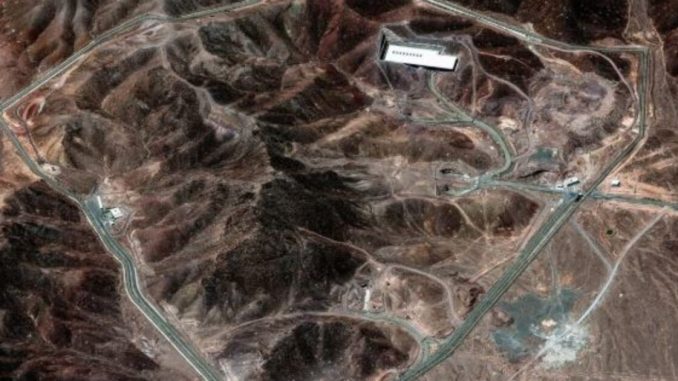
Fordo nuclear facility
| Published June 22, 2025
President Donald J. Trump addressed the nation Saturday night following a surprise U.S. military strike on Iranian nuclear infrastructure—an operation he described as a “complete and total obliteration” of Iran’s most fortified enrichment sites. The strikes, reportedly involving B‑2 stealth bombers and Tomahawk missiles, targeted Fordow, Natanz, and Isfahan, all of which have been central to Iran’s uranium enrichment program.
According to The Gateway Pundit, Trump took to Truth Social shortly after the operation to claim victory, stating:
“We have destroyed the underground Fordow nuclear facility—completely wiped out with bunker-busting precision. A spectacular success.”
Later President Trump posted on TRUTH Social that “Fordo is gone.”
The Reuters news agency confirmed the Pentagon had launched coordinated airstrikes late Friday night, using long-range stealth bombers that took off from the Pacific and refueled midair en route. The Fordow site, buried deep under a mountain, was reportedly hit with multiple precision-guided bombs, designed to penetrate hardened underground bunkers.
However, Iranian officials dispute the extent of the damage. They acknowledged structural impacts to Fordow’s tunnel systems but claimed that enriched uranium had been relocated before the strike. Tehran insisted the core of the facility remained intact. The IAEA reported no measurable radiation leaks, easing fears of widespread nuclear contamination.
In his televised address, Trump emphasized that the mission was not aimed at regime change, but at “halting Iran’s illegal path to a nuclear weapon.” He warned, however, that further military action remains on the table:
“Iran must now choose between peace and devastation. If they retaliate, the United States has many more targets.”
The Gateway Pundit hailed the strike as a “strategic masterstroke,” suggesting the use of decoy bombers had misled Iranian radar defense systems. Reuters did not independently confirm that detail but did note the operation’s success in avoiding detection and interception.
In the wake of the attack, Gulf nations including Saudi Arabia and the UAE raised security alerts. Meanwhile, Iran’s Revolutionary Guard vowed that the U.S. would “pay dearly,” declaring that “all options are on the table.”
 Implications
Implications
🔥 1. Military Escalation and Risk of War
The strikes significantly escalate U.S.–Iran tensions, pushing both nations closer to open conflict. While Trump emphasized the strikes were “limited,” Iran’s response remains uncertain. Retaliation could trigger a broader regional war involving Israel, U.S. bases in the Gulf, or Iran-backed proxies like Hezbollah and the Houthis.
⚛️ 2. Temporary Disruption to Iran’s Nuclear Program
If Fordow, Natanz, and Isfahan suffered real damage, Iran’s nuclear program may be delayed—but likely not dismantled. The program is deeply entrenched and has redundancies. While Trump called it a “complete obliteration,” satellite and IAEA reports suggest only partial success, especially with uranium already relocated.
🛢️ 3. Economic and Energy Shockwaves
Gulf states—like Saudi Arabia, Kuwait, and the UAE—have entered heightened alert, bracing for missile attacks or drone strikes on oil facilities. This has already caused a spike in oil prices, fueling fears of a global energy shock. If Iran targets oil infrastructure, the price impact could be severe and immediate.
🌐 4. Geopolitical Realignment
Trump’s bold move may reshape alliances:
-
Israel praised the strikes and may become more emboldened.
-
China and Russia condemned the attack, accusing the U.S. of provoking conflict.
-
Europe is caught in the middle—concerned about escalation but unwilling to openly oppose Washington.
This could deepen the East–West divide over Middle East policy.
🏛️ 5. 2026 Political Fallout in the U.S.
Trump’s decisive military action may rally supporters ahead of the 2026 midterms and reinforce his image as a strong leader on national security. However, if the conflict escalates or U.S. troops get pulled into a wider war, it could backfire politically—especially among independents and war-weary voters.
🧭 6. International Law and Precedent
The legality of the strikes is already under scrutiny. Critics argue the attack lacked congressional authorization and UN backing, potentially undermining norms around sovereignty and preemptive warfare. It sets a precedent: nuclear sites, even civilian, may now be seen as military targets.
💬 Overall Takeaway:
The U.S. airstrikes on Iran’s nuclear sites mark a historic turning point in the Middle East, signaling that the Trump administration is willing to use direct military force to halt Iran’s nuclear ambitions—without waiting for diplomacy, UN resolutions, or broader coalition support. While the White House and conservative outlets like The Gateway Pundit hail it as a decisive “obliteration,” more grounded reports from Reuters and international monitors suggest a strategic but limited strike with uncertain long-term effects.
The immediate outcome: a temporary disruption to Iran’s nuclear capabilities and a strong message of deterrence.
The long-term risk: retaliation, regional war, energy instability, and geopolitical fragmentation.
This operation may have reshaped the regional chessboard—but whether it secures peace or sparks wider conflict depends on how Iran responds, and how far Trump is willing to go if they strike back.
SOURCES: THE GATEWAY PUNDIT – President Trump on TRUTH Social: Fordow Nuclear Plant Is Gone
REUTERS – Trump says Iran’s key nuclear sites ‘obliterated’ by US airstrikes






Be the first to comment